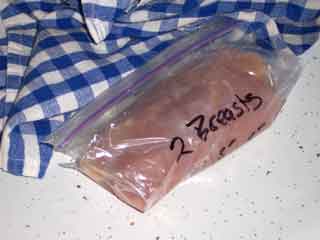
(‘Course, this time, I didn’t have enough ham. But there was some thin sliced roast beef kicking around, so what the heck. And as long as we’re taking liberties with the purity of the form, how about dicing up some ‘shrooms, and one of Woody’s home grown jalapenos. . . Look. It’s food. It’s supposed to be fun. So play with it!)

Ok, toss all your chopped up stuff into a mixing bowl and get ready to crack your eggs (which you did take out to warm up to room temperature, didn’t you . . .)
But instead of cracking the eggs straight into the bowl, where one rotten egg ruins everything, consider the plate method. Grab a bread plate or flat saucer and crack your egg onto it. If it’s OK, slide it into the bowl. Cracking the egg on a flat surface, rather then the edge of a bowl is much less likely to contribute eggshell to your recipe, and you won’t lose half the egg down the outside of the bowl!

When the eggs are in, grind on a frightening layer of Tellicherry, add a splash of milk, and whisk that mess into a froth. Now let it sit for 10 minutes or so while you warm your skillet, load up the toaster, flip the home fries, set the table, you get the idea . . .
Coat the bottom of the hot skillet with a light sheen of olive oil (or a little butter if you wish). You don’t want any puddle of oil in the pan, just a thin coat to keep that first contact of egg mixture from sticking.

Give your western a final whisk or three and pour it into the pan.

Now turn the heat down, rinse out your bowl and whisk, and do whatever other cleanup chores will take about 2 - 3 minutes.

By now, the edges of your western should have started to begin to show a little character. If the pan is still mainly soup, give it a very gentle tilt/roll/swirl to flow some of the egg a little farther up on the skillet wall.

You want to develop a sturdy enough outer edge that you can run a spatula all the way around the omelet without tearing or breaking any of it away. And you want to do this as soon as possible (after the first couple of minutes, that is).
When you can lift the edge of the omelet away from the edge of the pan, all the way around, check the clock. In about 15 minutes, you're going to flip your western. But every 5 minutes between now and then, you're going to slide that spatula all the way around the edge, slipping it closer to the center of the pan each time. On your final slide, the entire omelet should release easily from the surface of the skillet.

Five minutes later, it should be time to flip. If you're worried, you can lift the edges and peer underneath. The top of the omelet should be pretty well set, with little or no loose liquid. The bottom of the western should be a beautiful mottled brown, some parts dark, some light and some still a little yellow. If so, it's time to flip; if not, wait (but not too long . . .)
To flip the beast, make use of the back of a dinner plate (until you get the hang of flipping the entire thing in the pan, that is!) Just slide the omelet, cooked side down, out of the pan and onto the bottom side of a dinner plate.

Then, tilt the pan up as far as you dare, and in as close to one motion as you can manage, rotate that plate toward the skillet, slide the skillet under the plate, and dump the uncooked side of your western down onto the pan.

In about 2 minutes, start the edge separating again to make sure the bottom side doesn't stick to the pan (it's not likely to, but always worth checking!). In about 10 minutes, your dinner is ready!

Cut it in half, put it on plates, douse it heavily with ketchup (or not) and dive in!

(Okayokayokay, so I cooked this one a little too long on side one. Last one was a little pale; next one will be perfect; all are good!)



